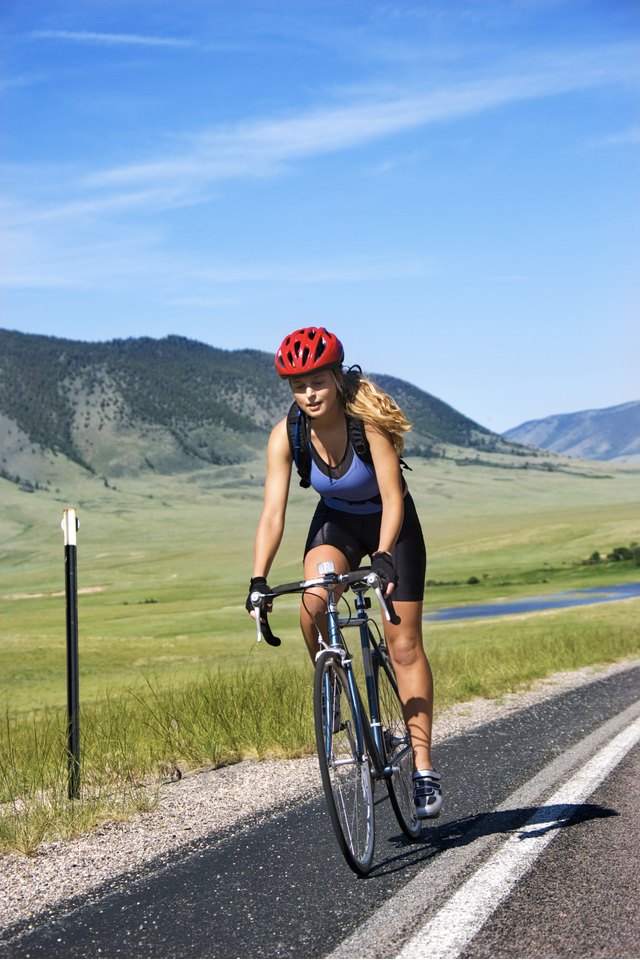What Is the Proper Way to Sit on a Bicycle When Riding It?

Bike sitting positions depend on what type of cycling you do. Cruising, racing, mountain or road biking all have different factors to take into consideration. Other fundamentals include wind, rough roads or downhill. You should become familiar with different types of seat posturing to fully engage in cycling. This enables you to ride any kind of bike you want, over any kind of terrain.
Cruisers
Cruising is relaxed and simple. It's done on large bikes with fat tires and wide seats. It involves sitting up straight with arms that are slightly bent reaching out to handlebars that are aptly raised so you don't have to reach down for them. This stance provides a sitting position that is straight up, similar to how you would sit in a chair. This type of riding is slow but comfortable. Two bones in your rear end -- also known as the sit-bones -- should be placed at the back of the seat on the softest part of the cushion. Sit down on the bike and slide back and forth slightly. You will feel a spot on the seat that will be more comfortable. When you feel it, stay there and you're ready to cruise.
Mountain Bike
Mountain bikes are semi-aggressive. Sit on the seat and reach out for the handlebars. Your torso should be leaned slightly forward, not hunched forward, but slightly tilted forward. If you're tilted to the point to where you have to bend your neck up to see what's in front of you, that's too much. Mountain biking requires a very clear view of obstacles and trail conditions. Mountain bike sitting posturing should be similar to cruising, but slightly hunched forward. The seat will be narrower than a cruiser seat, and possibly even with a split down the middle. Your sit bones should be at the back of the seat when riding, but when descending, you should slide your rear-end to the very back edge of the seat, almost off the back edge. The reverse is true for climbing. Stay in the saddle and slide your weight forward on the seat. The steeper the hill, the farther forward.
Road Bikes
Road bikes are the hardest of all bikes to get accustomed to. The hunched-forward sitting position if for aerodynamics and efficiency. Unlike mountain or cruisers, you will need to bend you neck up slightly to see properly, but even then, you will only be able to see a few yards in front of you without craning your neck at even a sharper angle. This position takes some getting used to but once you master it, you will go faster and farther. Road bike seats are narrow. There's often only two small soft spots on the seat for your sit-bones. Get on the bike and move your rear-end around until you find the soft spots, or the most balanced part of the seat, as these seats often have little or no significant padding. Road bike handlebars have three positions; in the drops, the lowest position will fully hunch your sitting position. In the grips, the pistol-like handles where your shifters are raise you up a bit, and on the hood or the top of the handlebars. Use this position to sit almost upright on the seat.
Aggressive Posture
Aggressive posture can be for any bike. It makes the bike go faster. Aggressive posture also aids in bike handling if the road is rough, it's windy or there are obstacles such as rocks or roots on the road or trail. Aggressive posture is sliding forward on the seat and hunched down as far as comfort will allow. For mountain or road bikes, this can be with your chest 16 to 18 inches from the handlebars. You can also pinch the seat between your legs and use the nose of the seat to help control the bike. Aggressive posture can't be held for distance rides, but when you need to use it, works well.
References
Writer Bio
Specializing in hardwood furniture, trim carpentry, cabinets, home improvement and architectural millwork, Wade Shaddy has worked in homebuilding since 1972. Shaddy has also worked as a newspaper reporter and writer, and as a contributing writer for Bicycling Magazine. Shaddy began publishing in various magazines in 1992, and published a novel, “Dark Canyon,” in 2008.
